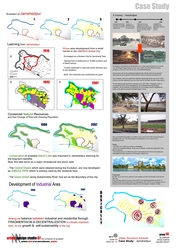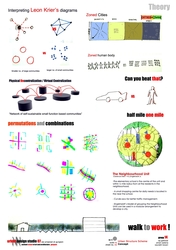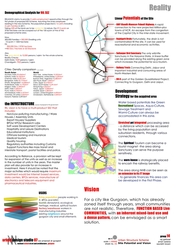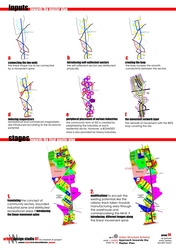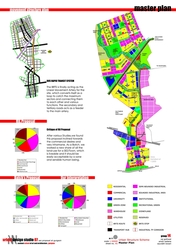Urban Design Studio
“Globalization could be the answer to many of the world's seemingly intractable problems. But this requires strong democratic foundations based on a political will to ensure equity and justice".” The quote above by Shane Burrow simultaneously reveals the both sides of the coin of Globalization, and its us who decides the toss.
Neo-millennial Economic boom by China surprised economic gurus and pandits of the world. India was no different. With the development in Information Technology sector, it was important to strategize the supplementary modes of development. Leaders of liberal-sect of government realized the potential of Free Economy in Indian context and envisaged the Special Economy Zones (SEZ) in India at larger Scale.
The 150hectare land bought up by RIL in Gurgaon-Jhajjar districts of Haryana was taken as studio exercise. The vision was of a holistic model was which is contextual and sensitive to the Indian context was the primary deliberation. After several Case Studies and a deep investigation of newly framed SEZ policies in Indian Constitution, 15 groups interpreted the site differently and came up with interesting concepts and programs.
Our vision and program was took shape from Krierian thoughts and ideas of small communities. However, the size was interpreted after all the rational and feasible calculations developed by the studio. One of the dreams and rarity of modernized world, Walk to Work, was integrated in the Community Concept. We interpreted the whole site in 15 ‘function based self-sufficient communities’. In other words the scheme is an interpretation of two dichotomous concepts, the Zoning and the Mixed-Use, applied at different ‘scales’ of planning and designing. Simultaneously, the Half-Mile thread of Clarence Stein was applied in a larger yarn. One must be wondering that how all these concepts can be weaved together. The solution lies in the physical decentralization and virtual centralization of the envisaged ‘communities’, with the ever-available support of Information Technology. This churning of ideas became the selling concept of the proposal.
On physically translating these entire concepts on the site, it was important to bind together the sprawled communities. The Mass Rapid Transport System connects the different communities on the linear site efficiently. The site was rich enough to provide clues and resources to be utilized locally and holistically.
- The Water based potentials on site like Green Recreational Spaces, Aqua-Culture, Sewage treatment and wormiculture can be accommodated along the clear Najafgarh drain in the North of the site. However, these functions have to be integrated intelligently in an efficient sequential order.
- The main processing area is kept stretched according to the site profile, so it can be accessed by the maximum without a minimum movement. It is also planned to catch the available transport opportunities like Railways and the proposed KMP highway.
- The thick Green area near the only Wildlife Sanctuary of Haryana, Sultanpur. Hence low-polluting options like Spiritual Tourism were explored to deal the issue sensitively.
- The existing development patterns were continued, like the extension of IT image along the NH-8 in the south of the site to generate revenue in the first phase.
The whole concept can be summed up in one statement, “For a city like Gurgaon, which has already zoned itself through years, in the matrix of space and time, small communities are not realistic. Therefore, Function-based live communities are envisaged as a smart solution”.
Neo-millennial Economic boom by China surprised economic gurus and pandits of the world. India was no different. With the development in Information Technology sector, it was important to strategize the supplementary modes of development. Leaders of liberal-sect of government realized the potential of Free Economy in Indian context and envisaged the Special Economy Zones (SEZ) in India at larger Scale.
The 150hectare land bought up by RIL in Gurgaon-Jhajjar districts of Haryana was taken as studio exercise. The vision was of a holistic model was which is contextual and sensitive to the Indian context was the primary deliberation. After several Case Studies and a deep investigation of newly framed SEZ policies in Indian Constitution, 15 groups interpreted the site differently and came up with interesting concepts and programs.
Our vision and program was took shape from Krierian thoughts and ideas of small communities. However, the size was interpreted after all the rational and feasible calculations developed by the studio. One of the dreams and rarity of modernized world, Walk to Work, was integrated in the Community Concept. We interpreted the whole site in 15 ‘function based self-sufficient communities’. In other words the scheme is an interpretation of two dichotomous concepts, the Zoning and the Mixed-Use, applied at different ‘scales’ of planning and designing. Simultaneously, the Half-Mile thread of Clarence Stein was applied in a larger yarn. One must be wondering that how all these concepts can be weaved together. The solution lies in the physical decentralization and virtual centralization of the envisaged ‘communities’, with the ever-available support of Information Technology. This churning of ideas became the selling concept of the proposal.
On physically translating these entire concepts on the site, it was important to bind together the sprawled communities. The Mass Rapid Transport System connects the different communities on the linear site efficiently. The site was rich enough to provide clues and resources to be utilized locally and holistically.
- The Water based potentials on site like Green Recreational Spaces, Aqua-Culture, Sewage treatment and wormiculture can be accommodated along the clear Najafgarh drain in the North of the site. However, these functions have to be integrated intelligently in an efficient sequential order.
- The main processing area is kept stretched according to the site profile, so it can be accessed by the maximum without a minimum movement. It is also planned to catch the available transport opportunities like Railways and the proposed KMP highway.
- The thick Green area near the only Wildlife Sanctuary of Haryana, Sultanpur. Hence low-polluting options like Spiritual Tourism were explored to deal the issue sensitively.
- The existing development patterns were continued, like the extension of IT image along the NH-8 in the south of the site to generate revenue in the first phase.
The whole concept can be summed up in one statement, “For a city like Gurgaon, which has already zoned itself through years, in the matrix of space and time, small communities are not realistic. Therefore, Function-based live communities are envisaged as a smart solution”.
